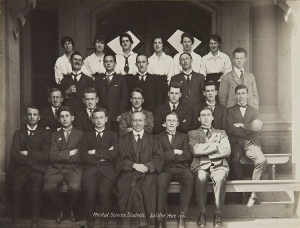Tags
1910s, jubilee, Knox, mental science, philosophy, psychology, St Margaret's, war

Professor Dunlop and mental science students in 1919. Image courtesy of the Hocken Collections, Album 89, S13-215b.
In 1919, as part of its jubilee celebrations, the university commissioned Charles Armstrong to photograph its buildings and people. This image comes from the wonderful album which resulted, now among the treasures held at the Hocken Collections. It features Professor Francis Dunlop and the mental science students. I can’t help thinking there should be another person in the front row – did somebody develop stage fright and run away at the last moment, perhaps?
Mental science (sometimes known as mental and moral philosophy) was a significant part of the university’s offerings for many decades. It combined two fields of study we now think of as distinctly different: philosophy and psychology. In 1919 the mental science course for beginning students included psychology and either ethics or logic (deductive and inductive). The advanced class included logic (“mainly viewed as the methodology of scientific enquiry”), psychology, and ethics (“in its full extent, treated both theoretically and historically”). There was also an honours class in the history of philosophy. Eventually psychology emerged from the shadow of philosophy and the arts faculty to become an independent department within the science faculty in 1964.
Dunlop, himself an Otago graduate, was Professor of Mental Science from 1913 until his death in 1931. Like his predecessor in the chair he was a Presbyterian minister; he completed his doctorate in Germany under Rudolf Eucken, a proponent of Lebensphilosophie, a form of idealism. Dunlop was famous for his enormous book collection and his steam-powered car.
An interesting feature of the class photograph is that several of the men are wearing prominent Returned Soldiers’ Association badges. There was a big jump in Otago student numbers in 1919 as men returned to, or began, their studies after the war. One of the returned servicemen in the class (second row from back, on the far right) is Hubert Ryburn. Ryburn returned to his Otago studies after serving in France, eventually completing a master’s degree in mathematics. He then went to Oxford on a Rhodes Scholarship, finished off his training in theology in New York and returned to New Zealand as a Presbyterian minister. In 1931, while minister of St Andrew’s Church, Dunedin, he married Jocelyn Dunlop, the daughter of his former mental science professor. From 1941 to 1963 Hubert Ryburn was Master of Knox College, where he was renowned for being “firm but fair”. After his retirement he moved to St Margaret’s College, where Jocelyn Ryburn was Warden until 1974. She was a stalwart of many organisations and served as president of one of New Zealand’s most influential bodies, the Plunket Society. Hubert Ryburn’s most significant contribution to the University of Otago came through the University Council, which he sat on from 1946. From 1955 to 1970 he was the highly capable Chancellor of his alma mater.
Do you recognise any other students in this photograph? If so, please get in touch!
